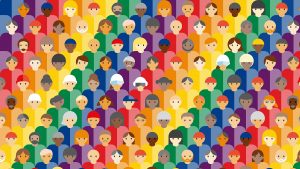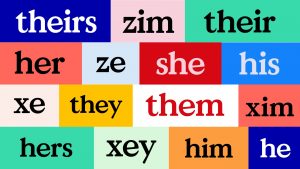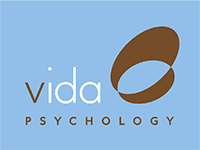23 Aug Language and Labels: How to use LGBTQIA+ inclusive language

By Sabrina Brient.
Language helps us to communicate and connect and to construct and express our identities. Language lets us create labels that we can share with others and build communities. As culture grows and changes, so too do the language and labels that we use.
It is important that we use language consciously and with respect. While labels can be used to build communities and include, labels can also be used to exclude, discriminate, or stereotype. Labels can cause harm if they are forced on someone who doesn’t want them or are dismissed as unimportant. Some people like having labels and may have several different ones to express their identities, i.e., partner, parent, lesbian, woman, teacher. While others resist labels altogether.
What is inclusive language?
Language becomes inclusive when it considers and respects the way people describe their own identities, bodies, genders, and relationships. We can make the language we use inclusive by using the words that someone uses to describe themselves and do so in a respectful and authentic way. Inclusive language helps create a sense of belonging, acknowledges the diversity of those around us and creating an open and respectful space for everyone. Inclusive language can help break down prejudice, stereotypes, and stigma (both intentional and unintentional), and helps to prevent violence.
How to use inclusive language:
The best way to determine how to use LGBTQIA+ labels is to listen to LGBTQIA+ people themselves but, outside of that, here are some basic points that can be helpful:
Labels:
- Don’t assume everyone is heterosexual/ straight: Avoid language that assumes heterosexuality, such as “wife and husband”, “boyfriend and girlfriend”, “mum and dad”. Examples of inclusive language you can use instead:
Partner, parents, relationship, in a relationship.
- Avoid language that assumes only two genders: women or men. For example, “ladies and gentlemen”, “boys and girls”. Also avoid assuming someone’s gender identity, such as assuming they are a man or a woman. Examples of inclusive language when referring to groups of people:
Everyone, family, friends, folks, team.
- Don’t make assumptions about someone’s identity, gender, sexuality, or relationships. If you need to, you can respectfully ask people what terms they use.
- Being LGBTQIA+ isn’t a personal choice or lifestyle choice. Don’t ask why they “choose” an identity, or what terms they “prefer”.
- Accept and respect someone’s identity and the language they use to describe themselves, and don’t question them or attempt to convince them otherwise. Use the terms that they use.
Pronouns:

- It is important to use the correct pronouns for people. When you do this, you are validating and respecting their gender identity.
- Most but not all men, including trans men, use the pronoun “he/him” and most but not all women, including trans women, use the pronoun “She/her”. However, it’s important not to assume this. Some people use a gender-neutral pronoun such as “they/them”.
- Some people use neo-pronouns, like “xe/xem” or “ze/zim”. And some people avoid pronouns altogether and use their name at all times.
- If you are unsure about someone’s pronoun, it is okay to ask them respectfully, “Can I ask what pronoun you use?”. Before asking, consider why you are asking. Do you need to know for a function or purpose, or are you asking out of curiosity?
- “They/them” can save you from needing to ask or making assumptions when meeting someone new. Alternatively, you can use the person’s name instead of a pronoun.
What if I make a mistake?
It is okay to make a mistake. No one will get everything right, all the time. The important thing is to try to use respectful language, and if you make a mistake, apologise, and continue the conversation. However, repeated mistakes can show a lack of respect and may feel deliberate- this can be very distressing and exhausting for the person who has to constantly correct you or be mis-labelled.
Things to avoid:
- Avoid using LGBTQIA+ terms in a derogatory way. For example, using the word “gay” in a negative way, either mockingly or in a derogatory tone.
- Avoid asking questions that you don’t need to know the answers to. Most people will find questions about their body or sexuality to be offensive or inappropriate. For example,
“Are you really a man/woman?” or “Did you used to be a man/woman?”
“Are you sure you’re gay/lesbian/bisexual? You look straight.”
“Who is the mother?” (in a same-sex parented family)
“But which one is the male?” (in a relationship where both identify as women)
This blog was written by Sabrina Brient, to learn more about Sabrina’s experience, click here.
To book an appointment with Sabrina or one of our other Psychologists, click here.


Sorry, the comment form is closed at this time.